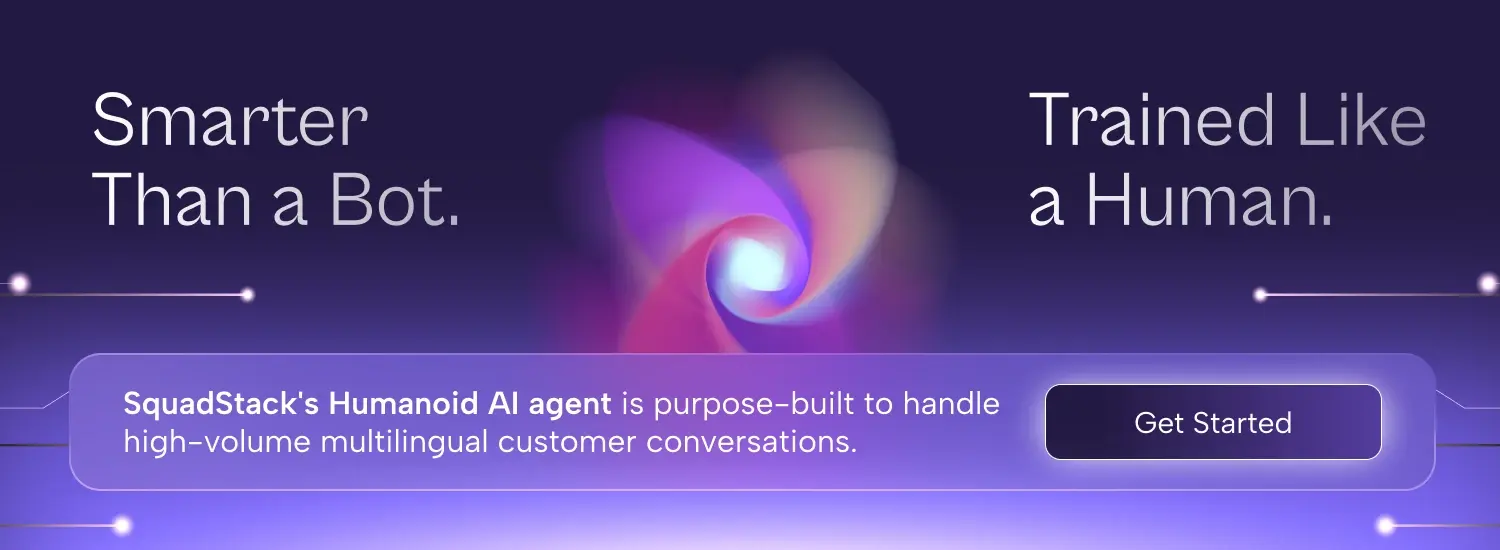Remember when we thought talking to a machine was something straight out of a sci-fi movie? Well, surprise! We're living in that future now, and it's more exciting than we ever imagined. Today, you can't walk into a business without bumping into some form of voice technology, but here's the twist: not all voice tech is created equal.
In the evolving world of Voicebots vs Voice AI Agents, two leading players are battling it out for dominance. Think of it like comparing a trusty old flip phone to a shiny new smartphone. Both make calls, but one can practically run your entire life while the other... well, just makes calls.
According to a recent Market.us report, the global voice AI agents market is expected to grow from USD 2.4 billion in 2024 to USD 47.5 billion by 2034, with a CAGR of 34.8%. That kind of growth shows how quickly businesses are shifting toward more innovative, more human-like conversational tech.
If you've ever found yourself screaming "HUMAN AGENT!" at your phone during a customer service call, you're not alone. Traditional voicebots, bless their digital hearts, have been trying their best but often leave us feeling more frustrated than a person trying to assemble IKEA furniture without instructions. But voice AI agents? They're changing the game entirely.
The difference between these two isn't just technical jargon; it's the difference between getting stuck in an endless loop of "I didn't understand that, please try again" and having a conversation that feels, well, human. With the Voicebots vs Voice Agents market heating up, it's clear that businesses are waking up to the reality that intelligent automation isn't optional anymore; it's the future.
"Gartner, the tech market researcher, has put out an estimate that AI agents will resolve 80% of common customer service queries by the year 2029."
— as cited in Wired's "Unpacking AI Agents" podcast
What Exactly Are Voicebots and How Do They Work?
To truly understand the debate around Voicebots vs Voice AI Agents, it's essential to start with the basics. Voicebots are like that friend who's excellent at memorising scripts but terrible at improvising. They follow pre-written paths and work with simple decision trees. When you call a company and hear "Press 1 for billing, press 2 for technical support," you're dealing with a voicebot's cousin, the Interactive Voice Response (IVR) system.
Traditional voicebots use Automatic Speech Recognition (ASR) to convert your speech into text, then match it against a database of possible responses. It's like playing a minimal game of 20 questions where the bot only knows about five questions and gets confused if you ask anything else.
The Technology Behind Traditional Voicebots
These systems rely on rule-based programming and keyword matching. Think of them as very sophisticated flowcharts that can talk. They're programmed to recognise specific phrases and respond with predetermined answers. If you say "billing," they know to route you to the billing department. If you say "payment issue," they might offer some basic troubleshooting steps.
The problem is, human conversation isn't a flowchart. We use different words to mean the same things, we change topics mid-sentence, and we sometimes don't even know exactly what we want when we start talking. Traditional voicebots struggle with this beautiful mess we call human communication.
Limitations That Drive Everyone Crazy
Here's where things get frustrating. Voicebots are like that overly literal friend who takes everything you say at face value. Say "I can't log into my account," and they might respond ideally. But say "I'm having trouble getting in," and suddenly they're confused because "getting in" wasn't in their script.
They also can't handle context switching. If you're talking about your billing issue and mention that you also need to update your address, the voicebot might lose track of your original problem entirely. It's like having a conversation with someone who has selective amnesia every 30 seconds.
Key Features of Traditional Voicebots
Understanding what traditional voicebots can and cannot do helps paint a clearer picture of their role in today's business landscape. These systems have served as the foundation of automated customer service for years, and while they have limitations, they offer certain advantages for specific use cases.
Voicebots excel in structured environments where conversations follow predictable patterns. They're particularly effective for simple tasks like account balance inquiries, appointment scheduling with fixed time slots, or basic information retrieval, where the customer's needs can be categorised into clear buckets.
Core Capabilities and Strengths
Traditional voicebots are built around keyword recognition and scripted responses. They can handle high call volumes for routine inquiries, work 24/7 without breaks, and provide consistent responses to frequently asked questions. Their strength lies in their reliability for simple, repetitive tasks where human-like conversation isn't necessary.
These systems can integrate with basic databases to retrieve information like account balances, order status, or store hours. They're also cost-effective for businesses that handle large volumes of simple inquiries without requiring sophisticated conversation capabilities.
Technical Specifications and Architecture
Voicebots typically use basic speech-to-text engines combined with rule-based decision trees. They work well in controlled environments where background noise is minimal and customers speak clearly. The architecture is straightforward: speech recognition converts voice to text, keyword matching identifies intent, and pre-programmed responses are delivered back to the customer.
The system maintains conversation state through simple session variables, allowing it to remember basic information like customer ID or selected menu options throughout a single call. However, this memory is limited and doesn't extend beyond basic data points needed for the current transaction.
As the market demand for more human-like, context-aware systems grows, the conversation around Voicebots vs Voice AI Agents is becoming more critical than ever, especially for businesses seeking more innovative, scalable, and engaging customer experiences.
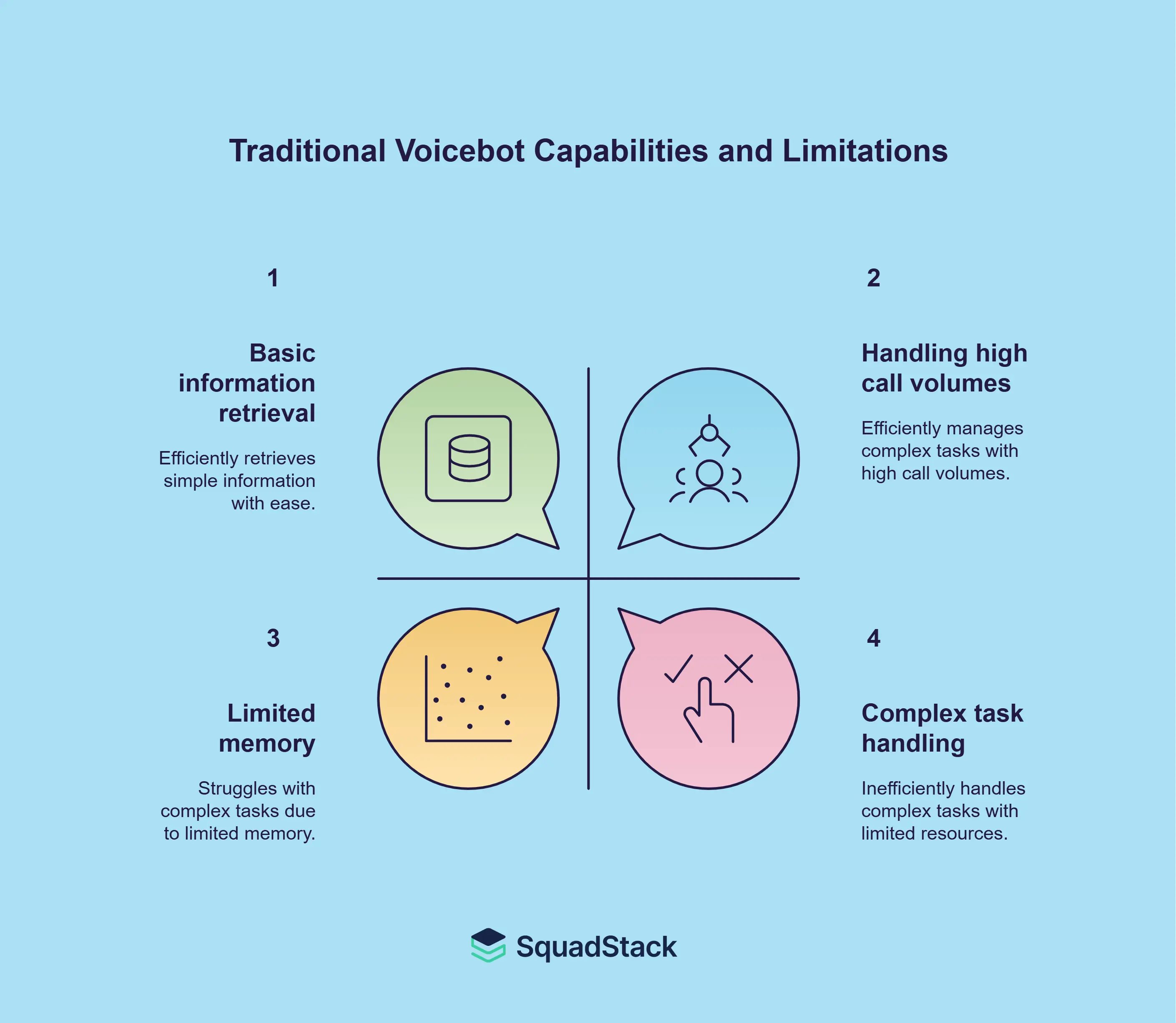
Voice AI Agents: The Smart Evolution of Voice Technology
The world of Voicebots vs Voice AI Agents, the contrast is becoming increasingly apparent. Now, let's talk about voice AI agents, the smart siblings who paid attention in conversation class. These aren't just upgraded voicebots; they're entirely different beasts built on advanced artificial intelligence and machine learning technologies. "Some people call this artificial intelligence, but the reality is this technology will enhance us. So instead of artificial intelligence, I think we'll augment our intelligence," this perfectly captures what voice AI agents do, they augment human-like conversation abilities.
Voice AI agents use sophisticated natural language processing (NLP) and natural language understanding (NLU) to comprehend what you're saying, not just match keywords. They can understand context, remember previous parts of the conversation, and even pick up on emotional cues in your voice.
The Brain Power Behind Voice AI Agents
These systems are powered by large language models and neural networks trained on massive amounts of conversational data. They don't just recognise words; they understand meaning, context, and intent. It's the difference between a parrot repeating phrases and a person understanding what you're talking about.
Voice AI agents can handle multiple topics in a single conversation, remember what you discussed earlier, and even make logical connections between different pieces of information. If you mention you're moving and need to update your address, then later ask about service availability, they'll connect the dots and check availability in your new location.
Real-World Magic in Action
Imagine calling your bank and having a conversation like this: "Hey, I'm travelling to Japan next month and want to make sure my cards will work there. Oh, and I noticed a weird charge on my account yesterday." A traditional voicebot would ask you to choose one issue or the other. A voice AI agent handles both, sets travel notifications for Japan, and investigates the suspicious charge, all in one smooth conversation.
This isn't science fiction; it's happening right now in businesses that have made the switch, a nd in the battle of Voicebots vs Voice AI Agents, the smarter, more contextual option is leading the way.
Key Features of Voice AI Agents
When evaluating Voicebots vs Voice AI Agents, the key difference lies in their ability to move beyond scripted responses and engage in intelligent, adaptive conversations. Voice AI agents represent a quantum leap in conversational technology, bringing capabilities previously only available through human agents. These systems don't just process voice commands; they engage in meaningful dialogue, understand context, and provide personalised solutions that adapt to each customer's unique situation.
The sophistication of voice AI agents extends far beyond simple command recognition. They can interpret emotional cues, handle complex multi-part requests, and maintain context throughout extended conversations. This makes them ideal for businesses that want to provide premium customer experiences without the overhead of large human agent teams.
Advanced Conversational Intelligence
Voice AI agents use natural language understanding to grasp not just what customers say, but what they mean. They can interpret requests spoken in different ways, understand implied needs, and even anticipate follow-up questions. This conversational intelligence allows them to guide customers through complex processes naturally and efficiently.
These systems can handle interruptions, topic changes, and even unclear requests by asking clarifying questions or making educated guesses based on context. They remember conversation history and can reference earlier parts of the discussion, creating a seamless experience that feels genuinely helpful rather than robotic.
Machine Learning and Continuous Improvement
Unlike traditional voicebots, voice AI agents learn from every interaction. They identify successful conversation patterns, recognise common customer pain points, and automatically adjust their responses to improve future interactions. This continuous learning means the system gets more innovative and more effective over time without requiring manual programming updates.
The machine learning capabilities extend to understanding industry-specific terminology, recognising regional accents and speech patterns, and adapting to the unique communication style of different customer segments. This personalisation creates more engaging and effective customer interactions.
Integration and Workflow Automation
Voice AI agents can seamlessly integrate with CRM systems, databases, and business applications to access real-time information and perform actions on behalf of customers. They can process payments, schedule appointments, update account information, and trigger workflows across multiple systems, all through natural conversation.
This integration capability means customers can accomplish complex tasks through a single conversation rather than being transferred between different systems or departments. The AI agent becomes a unified interface to a company's services and capabilities.
Ultimately, the capabilities outlined here make it clear why Voicebots vs Voice AI Agents is more than a technological comparison; it's a strategic decision that shapes how businesses engage with customers in a more human, scalable, and intelligent way.
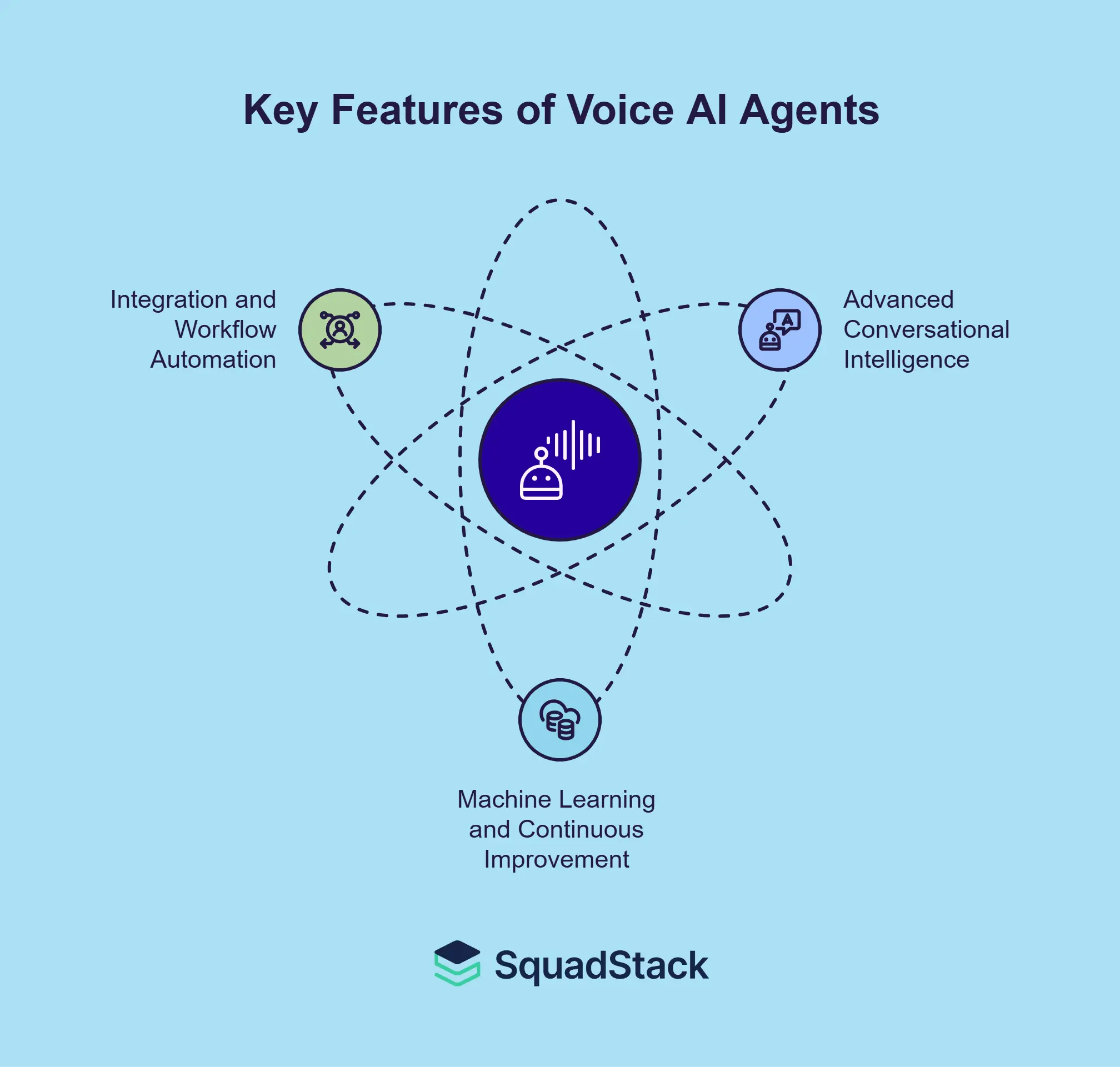
Key Differences That Matter to Your Business
The gap in Voicebots vs Voice AI Agents isn't just about being fancy with technology, it's about real business impact. Let's break down the differences that truly affect your bottom line and customer satisfaction scores in a clear, easy-to-compare format.
Traditional voicebots are reactive; they wait for specific inputs and respond with preset outputs. Voice AI agents are proactive; they can guide conversations, ask clarifying questions, and even anticipate what customers might need next. It's like the difference between a vending machine and a helpful store clerk.
When comparing Voicebots vs Voice AI Agents, it becomes clear: voice AI agents deliver superior experiences, smarter operations, and long-term value that businesses can't afford to ignore.
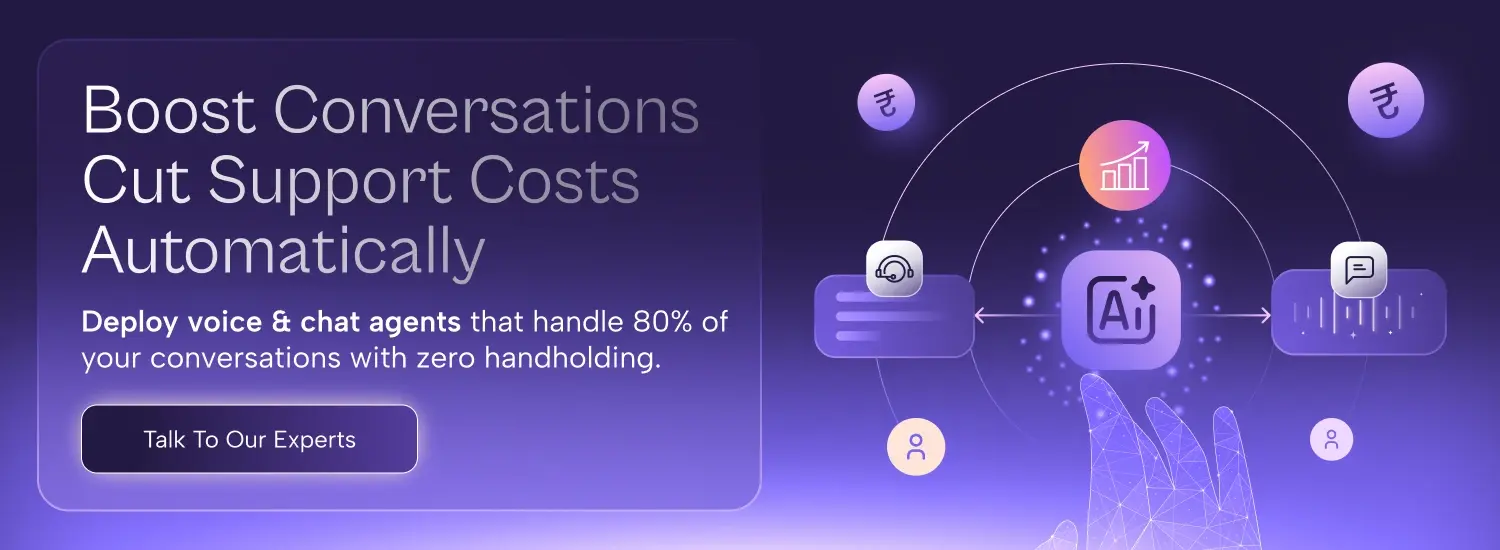
Why AI Voice Agents Outshine Traditional Voicebots
The difference between a voicebot and a voice AI agent isn't just technical; it's experiential. While both are designed to handle voice-based interactions, only one feels natural, helpful, and human. Voice AI agents bring warmth, intelligence, and adaptability to customer conversations, something traditional voicebots still struggle to deliver.
The growing debate of Voicebots vs Voice AI Agents boils down to the level of intelligence, emotional understanding, and contextual learning each can offer. Let's break down the specific benefits voice AI agents bring.
Conversation Flow and Natural Interaction
Here's where the rubber meets the road. Voicebots create conversations that feel like interrogations: "What is your account number?" "What is your date of birth?" "What is the nature of your inquiry?" It's robotic, cold, and frankly, annoying.
Voice AI agents create conversations that feel... well, like conversations. They can say, "I'd be happy to help you. To get started, I'll need to verify your account. Can you give me your account number or the phone number associated with your account?" See the difference? It's warmer, more natural, and explains why they need the information.
People remember how they were treated. An intelligent voice AI system doesn't just answer, it listens.
Problem-Solving Capabilities That Wow Customers
Traditional voicebots are like having a conversation with a very polite brick wall. They can handle simple, straightforward requests but crumble when faced with anything complex or nuanced.
Voice AI agents, on the other hand, can handle multi-layered problems, connect different pieces of information, and even offer creative solutions. For example, if a customer calls about a billing dispute but mentions they're considering cancelling their service during the conversation, a voice AI agent can address the billing issue and proactively offer retention solutions. A traditional voicebot would handle billing disputes and miss the cancellation risk entirely.
Seamless Escalation and Human Collaboration
When a voicebot hits a dead end, it either loops endlessly or ends the call awkwardly. Escalation, if it happens at all, often lacks context, forcing customers to repeat themselves.
Voice AI agents know when to hand off to a human and do so smoothly, with full context and conversation history. This means no re-explaining, no awkward silences, and a more cohesive experience from start to finish. It's a more innovative, more respectful approach that modern customers expect.
Voice Tone and Brand Personality
One area where traditional voicebots fall short is representing a brand's unique voice. Their tone is often rigid, transactional, and flat, leaving customers with a generic and sometimes frustrating experience. There's no warmth, no empathy, and certainly no personalisation in tone or delivery.
Voice AI agents, however, can be trained to match your brand's personality. Whether your business tone is friendly, professional, quirky, or empathetic, AI agents can mirror that consistently across every customer interaction. They adjust their language, pace, and even sentence structure based on the emotional context of the conversation, helping your brand sound more human, more relatable, and more trustworthy.
Data Privacy and Security Built-In
In today's compliance-driven world, customer data handling is as important as customer experience. Traditional voicebots offer limited built-in safeguards, often relying on external systems for data security, leading to fragmented and sometimes risky setups.
Voice AI agents, by contrast, are designed with data privacy and compliance in mind. Many are built to meet global standards like GDPR, HIPAA, and PCI-DSS. They can encrypt sensitive information, mask personal details in real time, and follow strict protocols to ensure secure storage and access. This makes them especially valuable for businesses in regulated industries like healthcare, finance, or insurance, where trust and security aren't optional; they're mandatory.
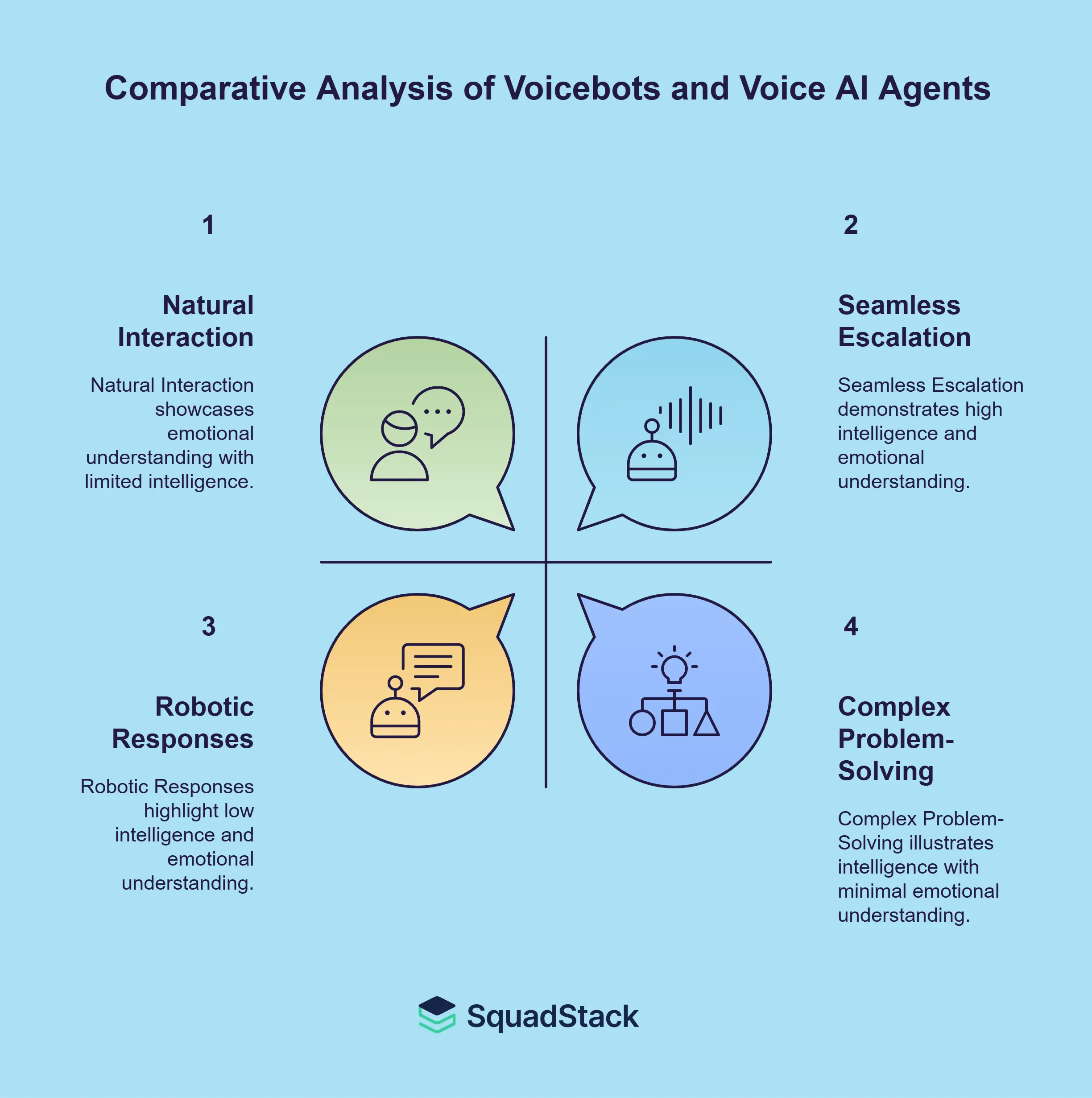
The Business Impact: What are the Benefits of Upgrading from Voicebots to Voice AI Agents?
The numbers don't lie, and they're telling a compelling story. Companies that have made the switch from traditional voicebots to voice AI agents are seeing dramatic improvements across every metric that matters.
66% believe AI will change their jobs in the next 5 years, and in the voice technology space, that change is happening right now. Businesses are discovering that voice AI agents aren't just better at handling calls, they're transforming entire customer experience strategies. The shift in Voicebots vs Voice AI Agents isn't just technical; it's deeply tied to how modern companies operate, compete, and scale.
Customer Satisfaction Scores Through the Roof
When customers can have natural conversations and get their problems solved on the first call, satisfaction scores naturally improve. Companies report 40-60% improvements in customer satisfaction ratings after switching to voice AI agents. But it's not just about the scores, it's about what those scores represent: customers who feel heard, understood, and valued.
The traditional voicebot experience often leaves customers feeling frustrated and unheard. They end up repeating themselves multiple times, getting transferred between different systems, and ultimately demanding to speak to a human agent. Voice AI agents eliminate most pain points by understanding context and handling complex requests.
A leading direct-to-consumer (D2C) e-commerce brand transitioned from a traditional voicebot to a voice AI agent and reported a 45% drop in call escalations, a 35% increase in first-call resolution, and a 3x boost in CSAT scores within 90 days. The AI agent's ability to understand context, personalise conversations, and proactively handle retention scenarios made a measurable difference in support efficiency and customer loyalty.
Cost Savings That Make CFOs Smile
Here's something that gets executives excited: voice AI agents handle more calls successfully without human intervention. While the initial investment might be higher than basic voicebots, the ROI comes quickly through reduced call transfer rates, shorter call times, and improved first-call resolution rates.
Companies typically see a 30-50% reduction in calls that need to be escalated to human agents. When you multiply that across hundreds or thousands of daily calls, the cost savings add up quickly. Plus, the voice AI agents work 24/7 without breaks, sick days, or vacation time.
Operational Efficiency That Scales
Traditional voicebots require constant manual updates and script modifications. Every new product, service change, or policy update means someone has to update the system manually. Voice AI agents learn and adapt more naturally, requiring less manual maintenance and updating as they interact with more customers.
This scalability is crucial for growing businesses. As companies expand their services or enter new markets, voice AI agents can adapt and learn new contexts without requiring complete reprogramming. The debate of Voicebots vs Voice AI Agents becomes crystal clear when businesses need solutions that evolve effortlessly with their growth.
" AI agents can hold conversations with insurers, adapt questions contextually, and escalate unclear issues, performing the work of over 100 full‑time employees and quadrupling processing speed."
— Business Insider report on voice AI in healthcare
Multilingual Capabilities That Break Language Barriers
One of the often-overlooked benefits in the Voicebots vs Voice AI Agents comparison is multilingual support. Traditional voicebots typically rely on pre-scripted flows in one or two languages, limiting their effectiveness in linguistically diverse markets. If a customer uses mixed phrases or switches languages mid-sentence, voicebots often fail to understand or respond correctly.
Voice AI agents, however, are built with advanced natural language understanding and multilingual training. They can fluidly handle conversations in multiple languages, understand regional dialects, and even switch context mid-call without losing comprehension. This makes them ideal for global businesses or companies operating in multilingual regions like India or Southeast Asia, where delivering support in local languages isn't just a feature, it's a necessity.
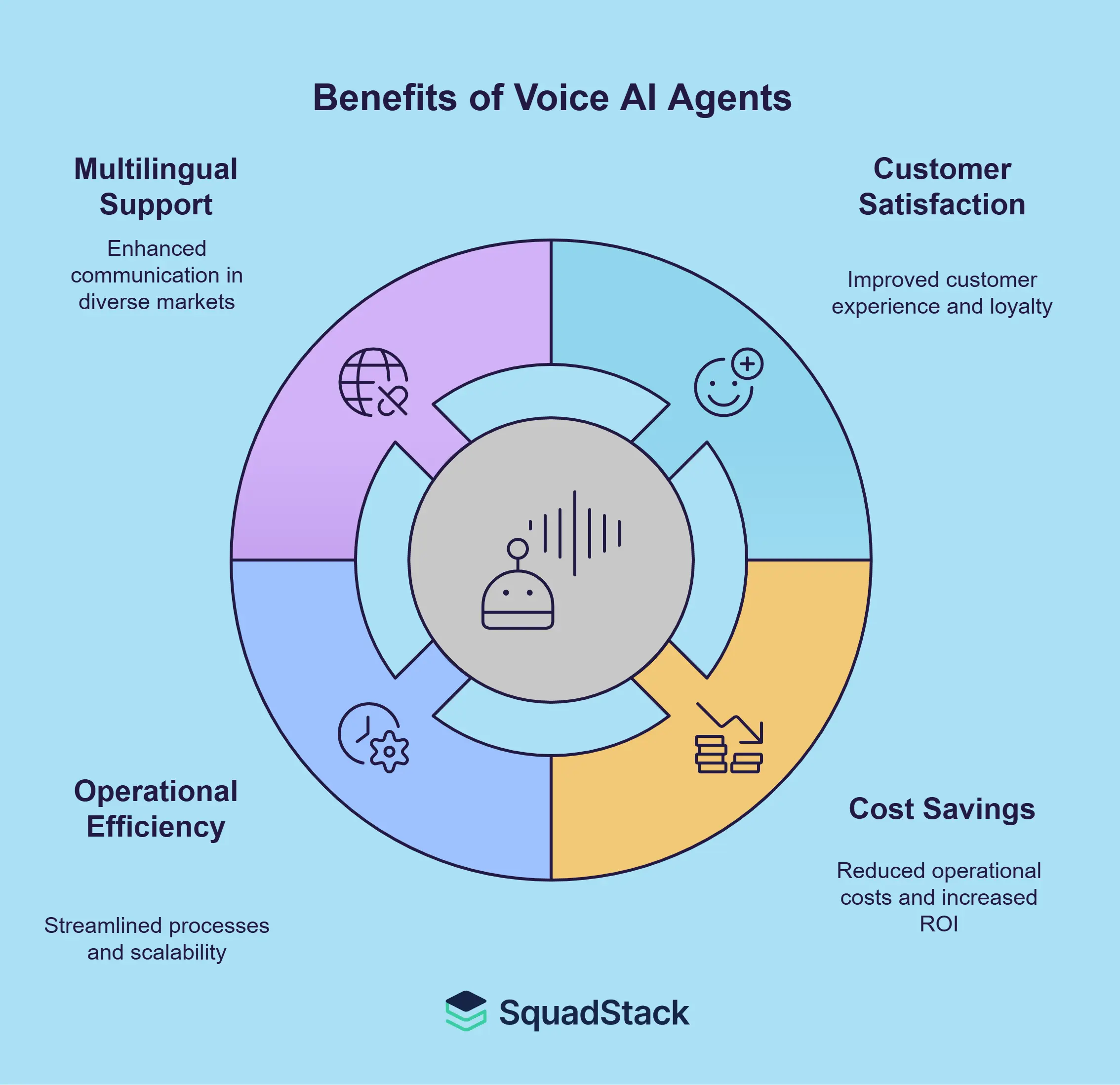
Future-Proofing with Voice AI Agents: Why They Outperform Voicebots
Businesses need to think strategically about where they invest their resources. The question isn't whether voice technology will become more critical; it's whether your business will be ready when AI-powered conversations become the norm. In the comparison of Voicebots vs Voice AI Agents, the real decision is about future readiness: which one will evolve with customer expectations?
Integration Capabilities and Ecosystem Compatibility
Modern voice AI agents don't work in isolation. They integrate seamlessly with CRMs, helpdesks, knowledge bases, and other essential tools. This allows them to access customer history, update records in real-time, and tailor conversations based on past behaviour.
By contrast, traditional voicebots often operate as standalone systems. They require manual configuration, struggle with dynamic environments, and need more effort to keep synced with existing tech stacks. Voice AI agents are designed for plug-and-play compatibility, using modern APIs that make integration painless and scalable.
Continuous Learning and Real-Time Optimisation
The most exciting capability of voice AI agents is their ability to improve autonomously. Every customer interaction becomes a learning opportunity, helping the system identify patterns, optimise conversation paths, and reduce friction with each call.
Traditional voicebots, on the other hand, require constant manual updates and human review to improve. They don't "learn"; they rely on fixed scripts and workflows. Voice AI agents close this gap by continuously adapting and evolving, which is critical for businesses that want to scale support and stay competitive.
Preparing for Tomorrow's Customer Expectations
Customer expectations have changed. People now engage with sophisticated AI on their phones and in their homes, and they expect the same level of intelligence and personalisation when talking to your business.
Companies that continue relying on basic voicebots risk falling behind and frustrating customers. Voice AI agents help future-proof your brand by delivering conversations that feel modern, helpful, and emotionally intelligent. In the evolving race of Voicebots vs Voice AI Agents, only one is built to meet the next generation of customer service demands.
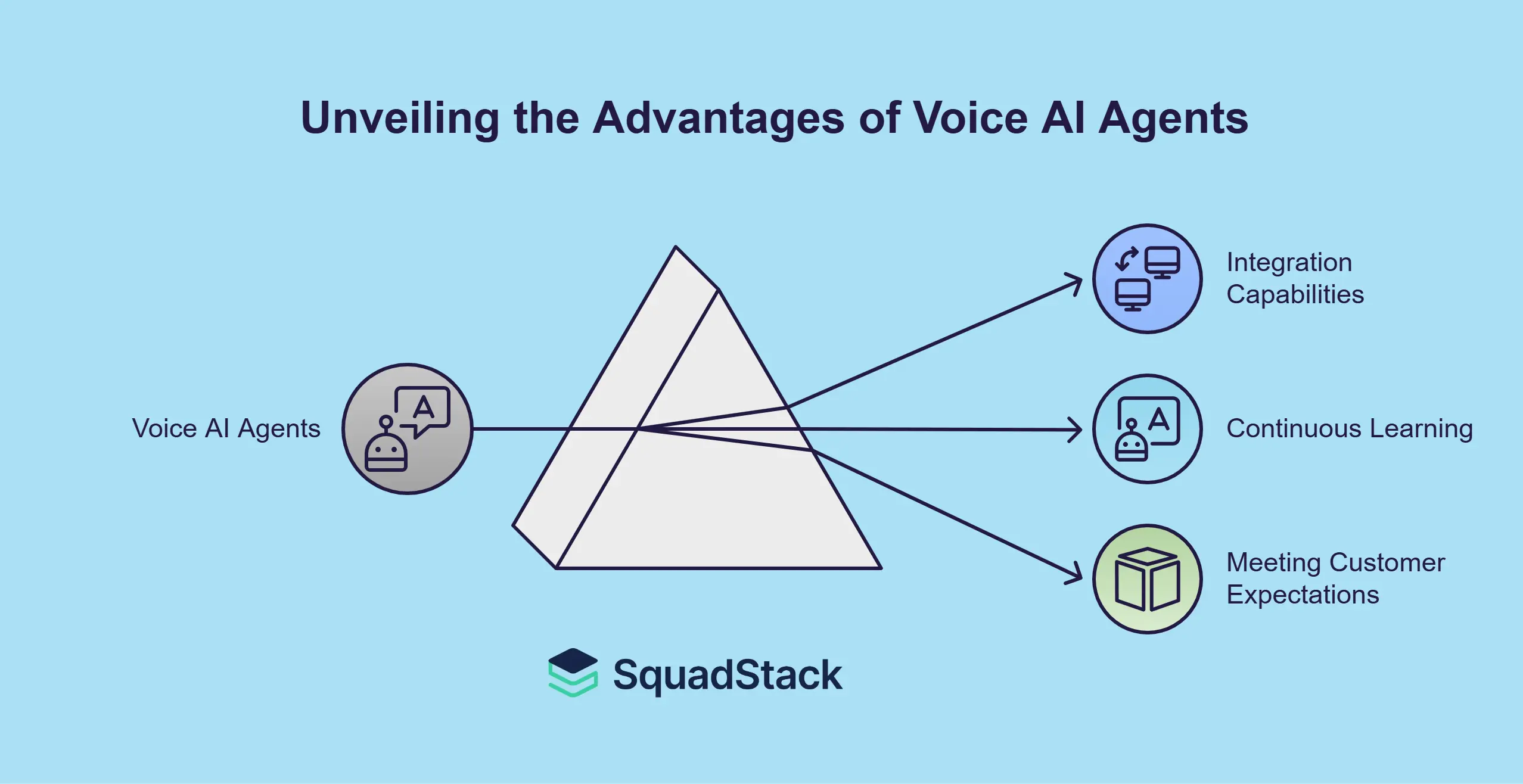
SquadStack's AI Voice Agent: Leading the Revolution
SquadStack's Humanoid AI Voice Agent is trained on over 90 million minutes of honest human conversations, making it remarkably capable of understanding nuance, emotion, and intent in real time. It delivers outcome-focused conversations that feel natural, allowing businesses to scale humanlike voice support with unprecedented efficiency.
Built for Humanlike, Outcome-Driven Support
This AI agent isn't just about automation—it's designed to engage, solve, and deliver. Conversations feel seamless and empathetic, with every response fine-tuned for clarity and contextual relevance.
- Trained on 90 M+ minutes of human support interactions.
- Delivers dynamic, humanlike voice experiences.
- Designed for resolution, not just scripted responses.
- Built-in analytics and VOC (Voice of Customer) insights for ongoing optimisation.
Designed for Real-World Contact Centre Environments
Whether it's a noisy background or a customer switching languages mid-call, SquadStack's AI agent adapts intelligently. It handles complexity like a human would, but with the consistency and speed of AI.
- Language switching and 360° context awareness.
- Real-time noise suppression and interruption handling.
- Seamless live handoff from AI to human agents, with full context maintained.
- Omnichannel compatibility for voice, chat, and more.
Scales Without Breaking Your Operations
Traditional voice systems require retraining, manual SOP updates, and time-consuming reconfiguration. SquadStack removes those roadblocks, allowing you to scale with speed and stability.
- SOPs can be updated instantly without breaking workflows.
- Scale teams up or down without retraining the AI.
- Train new agents in days, not weeks.
- Go live in just 3 days with all-inclusive pricing per connected minute.
SquadStack's AI Voice Agent isn't just keeping up with the future of customer service—it's building it. With flexibility, intelligence, and control baked into the system, it's the most efficient way to deliver scalable, humanlike conversations that drive real results.
Also, check the AI Call Centre
Conclusion: Voicebots vs Voice AI Agents
A voicebot is a conversational AI tool that interacts with users through voice, using speech recognition and natural language processing to understand and respond to spoken queries. It's ideal for handling basic, repetitive tasks in a structured way, making it a valuable solution for businesses looking to automate simple customer interactions.
An AI voice agent, on the other hand, is a more advanced form of conversational AI. It not only understands voice inputs but also makes autonomous decisions, handles complex scenarios, and learns from previous interactions to continually improve its performance. This makes it far better suited for dynamic, high-stakes customer conversations.
When comparing Voicebots vs Voice AI Agents, it's clear that each serves a different purpose in the automation spectrum. Here's a closer comparison:
Voicebot
A voicebot is a rule-based conversational AI that interacts with users through voice commands. It's designed to follow predefined scripts and handle routine, straightforward tasks with speed and consistency.
Function:Designed for fundamental customer service interactions, such as answering common questions, providing account or order information, and routing calls to the correct department.
Technology:Uses automatic speech recognition (ASR) to transcribe speech to text, and natural language processing (NLP) to understand intent. It operates based on predefined rules or flows.
Interaction Style:Scripted and limited in flexibility. Voicebots are best for routine or predictable tasks where responses don't require much variation or judgment.
Examples:Answering FAQs, checking delivery status, scheduling appointments, or resetting passwords.
AI Voice Agent
An AI voice agent is an advanced virtual assistant powered by machine learning and natural language intelligence. It can understand context, make decisions, and evolve through interactions to deliver more human-like support.
Function:Handles more complex requests, makes real-time decisions, and improves with every interaction. It goes beyond just answering queries; it can reason, personalise, and act.
Technology:Powered by advanced AI, including large language models (LLMs), machine learning, and contextual understanding. This allows it to respond intelligently, even in unfamiliar situations.
Interaction Style:Dynamic and adaptive. AI voice agents can change their responses based on the user's history, tone, or the context of the conversation, delivering a more natural and helpful experience.
Examples:Resolving billing disputes, walking users through troubleshooting steps, handling refund escalations, or offering personalised upselling based on past behaviour.
In essence, Voicebots vs Voice AI Agents is a comparison of simplicity versus intelligence. Voicebots are best for structured, low-complexity tasks. AI voice agents are built for real-time decision-making, personalised service, and continuous learning. As customer expectations rise, businesses aiming to deliver fast, intelligent, and human-like experiences should consider adopting AI voice agents as a strategic upgrade to traditional voicebot solutions.
